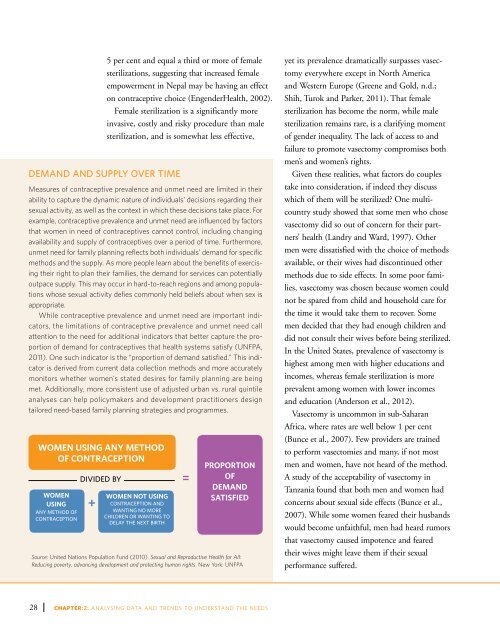State of World Population 2012 - Country Page List - UNFPA
State of World Population 2012 - Country Page List - UNFPA
State of World Population 2012 - Country Page List - UNFPA
You also want an ePaper? Increase the reach of your titles
YUMPU automatically turns print PDFs into web optimized ePapers that Google loves.
Demand and supply over time<br />
5 per cent and equal a third or more <strong>of</strong> female<br />
sterilizations, suggesting that increased female<br />
empowerment in Nepal may be having an effect<br />
on contraceptive choice (EngenderHealth, 2002).<br />
Female sterilization is a significantly more<br />
invasive, costly and risky procedure than male<br />
sterilization, and is somewhat less effective,<br />
Measures <strong>of</strong> contraceptive prevalence and unmet need are limited in their<br />
ability to capture the dynamic nature <strong>of</strong> individuals’ decisions regarding their<br />
sexual activity, as well as the context in which these decisions take place. For<br />
example, contraceptive prevalence and unmet need are influenced by factors<br />
that women in need <strong>of</strong> contraceptives cannot control, including changing<br />
availability and supply <strong>of</strong> contraceptives over a period <strong>of</strong> time. Furthermore,<br />
unmet need for family planning reflects both individuals’ demand for specific<br />
methods and the supply. As more people learn about the benefits <strong>of</strong> exercising<br />
their right to plan their families, the demand for services can potentially<br />
outpace supply. This may occur in hard-to-reach regions and among populations<br />
whose sexual activity defies commonly held beliefs about when sex is<br />
appropriate.<br />
While contraceptive prevalence and unmet need are important indicators,<br />
the limitations <strong>of</strong> contraceptive prevalence and unmet need call<br />
attention to the need for additional indicators that better capture the proportion<br />
<strong>of</strong> demand for contraceptives that health systems satisfy (<strong>UNFPA</strong>,<br />
2011). One such indicator is the “proportion <strong>of</strong> demand satisfied.” This indicator<br />
is derived from current data collection methods and more accurately<br />
monitors whether women’s stated desires for family planning are being<br />
met. Additionally, more consistent use <strong>of</strong> adjusted urban vs. rural quintile<br />
analyses can help policymakers and development practitioners design<br />
tailored need-based family planning strategies and programmes.<br />
WOMEN USING ANY METHOD<br />
OF CONTRACEPTION<br />
WOMEN<br />
USING<br />
ANY METHOD OF<br />
CONTRACEPTION<br />
DIVIDED BY<br />
+<br />
WOMEN NOT USING<br />
CONTRACEPTION AND<br />
WANTING NO MORE<br />
CHILDREN OR WANTING TO<br />
DELAY THE NEXT BIRTH<br />
Source: United Nations <strong>Population</strong> Fund (2010). Sexual and Reproductive Health for All:<br />
Reducing poverty, advancing development and protecting human rights. New York: <strong>UNFPA</strong><br />
=<br />
PROPORTION<br />
OF<br />
DEMAND<br />
SATISFIED<br />
yet its prevalence dramatically surpasses vasectomy<br />
everywhere except in North America<br />
and Western Europe (Greene and Gold, n.d.;<br />
Shih, Turok and Parker, 2011). That female<br />
sterilization has become the norm, while male<br />
sterilization remains rare, is a clarifying moment<br />
<strong>of</strong> gender inequality. The lack <strong>of</strong> access to and<br />
failure to promote vasectomy compromises both<br />
men’s and women’s rights.<br />
Given these realities, what factors do couples<br />
take into consideration, if indeed they discuss<br />
which <strong>of</strong> them will be sterilized One multicountry<br />
study showed that some men who chose<br />
vasectomy did so out <strong>of</strong> concern for their partners’<br />
health (Landry and Ward, 1997). Other<br />
men were dissatisfied with the choice <strong>of</strong> methods<br />
available, or their wives had discontinued other<br />
methods due to side effects. In some poor families,<br />
vasectomy was chosen because women could<br />
not be spared from child and household care for<br />
the time it would take them to recover. Some<br />
men decided that they had enough children and<br />
did not consult their wives before being sterilized.<br />
In the United <strong>State</strong>s, prevalence <strong>of</strong> vasectomy is<br />
highest among men with higher educations and<br />
incomes, whereas female sterilization is more<br />
prevalent among women with lower incomes<br />
and education (Anderson et al., <strong>2012</strong>).<br />
Vasectomy is uncommon in sub-Saharan<br />
Africa, where rates are well below 1 per cent<br />
(Bunce et al., 2007). Few providers are trained<br />
to perform vasectomies and many, if not most<br />
men and women, have not heard <strong>of</strong> the method.<br />
A study <strong>of</strong> the acceptability <strong>of</strong> vasectomy in<br />
Tanzania found that both men and women had<br />
concerns about sexual side effects (Bunce et al.,<br />
2007). While some women feared their husbands<br />
would become unfaithful, men had heard rumors<br />
that vasectomy caused impotence and feared<br />
their wives might leave them if their sexual<br />
performance suffered.<br />
28 CHAPTER:<br />
2: ANALYSING DATA AND TRENDS TO UNDERSTAND THE needs
















